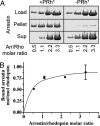Each rhodopsin molecule binds its own arrestin
- PMID: 17360618
- PMCID: PMC1805568
- DOI: 10.1073/pnas.0610886104
Each rhodopsin molecule binds its own arrestin
Abstract
Arrestins (Arrs) are ubiquitous regulators of the most numerous family of signaling proteins, G protein-coupled receptors. Two models of the Arr-receptor interaction have been proposed: the binding of one Arr to an individual receptor or to two receptors in a dimer. To determine the binding stoichiometry in vivo, we used rod photoreceptors where rhodopsin (Rh) and Arr are expressed at comparably high levels and where Arr localization in the light is determined by its binding to activated Rh. Genetic manipulation of the expression of both proteins shows that the maximum amount of Arr that moves to the Rh-containing compartment exceeds 80%, but not 100%, of the molar amount of Rh present. In vitro experiments with purified proteins confirm that Arr "saturates" Rh at a 1:1 ratio. Thus, a single Rh molecule is necessary and sufficient to bind Arr. Remarkable structural conservation among receptors and Arrs strongly suggests that all Arr subtypes bind individual molecules of their cognate receptors.
Conflict of interest statement
The authors declare no conflict of interest.
Figures


Similar articles
-
Constitutively active rhodopsin mutants causing night blindness are effectively phosphorylated by GRKs but differ in arrestin-1 binding.Cell Signal. 2013 Nov;25(11):2155-62. doi: 10.1016/j.cellsig.2013.07.009. Epub 2013 Jul 17. Cell Signal. 2013. PMID: 23872075 Free PMC article.
-
Rapid degeneration of rod photoreceptors expressing self-association-deficient arrestin-1 mutant.Cell Signal. 2013 Dec;25(12):2613-24. doi: 10.1016/j.cellsig.2013.08.022. Epub 2013 Sep 3. Cell Signal. 2013. PMID: 24012956 Free PMC article.
-
Arrestin and its splice variant Arr1-370A (p44). Mechanism and biological role of their interaction with rhodopsin.J Biol Chem. 2002 Nov 15;277(46):43987-96. doi: 10.1074/jbc.M206211200. Epub 2002 Aug 22. J Biol Chem. 2002. PMID: 12194979
-
Structure and self-association of Arrestin-1.J Struct Biol. 2025 Mar;217(1):108173. doi: 10.1016/j.jsb.2025.108173. Epub 2025 Jan 27. J Struct Biol. 2025. PMID: 39880147 Review.
-
Custom-designed proteins as novel therapeutic tools? The case of arrestins.Expert Rev Mol Med. 2010 Apr 23;12:e13. doi: 10.1017/S1462399410001444. Expert Rev Mol Med. 2010. PMID: 20412604 Free PMC article. Review.
Cited by
-
Engineering visual arrestin-1 with special functional characteristics.J Biol Chem. 2013 Feb 1;288(5):3394-405. doi: 10.1074/jbc.M112.445437. Epub 2012 Dec 17. J Biol Chem. 2013. PMID: 23250748 Free PMC article.
-
Light-dependent phosphorylation of Bardet-Biedl syndrome 5 in photoreceptor cells modulates its interaction with arrestin1.Cell Mol Life Sci. 2013 Dec;70(23):4603-16. doi: 10.1007/s00018-013-1403-4. Epub 2013 Jul 2. Cell Mol Life Sci. 2013. PMID: 23817741 Free PMC article.
-
β-arrestin1 promotes tauopathy by transducing GPCR signaling, disrupting microtubules and autophagy.Life Sci Alliance. 2021 Dec 3;5(3):e202101183. doi: 10.26508/lsa.202101183. Print 2022 Mar. Life Sci Alliance. 2021. PMID: 34862271 Free PMC article.
-
Photochemistry of retinal chromophore in mouse melanopsin.Proc Natl Acad Sci U S A. 2008 Jul 1;105(26):8861-5. doi: 10.1073/pnas.0711397105. Epub 2008 Jun 25. Proc Natl Acad Sci U S A. 2008. PMID: 18579788 Free PMC article.
-
JNK3 enzyme binding to arrestin-3 differentially affects the recruitment of upstream mitogen-activated protein (MAP) kinase kinases.J Biol Chem. 2013 Oct 4;288(40):28535-47. doi: 10.1074/jbc.M113.508085. Epub 2013 Aug 19. J Biol Chem. 2013. PMID: 23960075 Free PMC article.
References
Publication types
MeSH terms
Substances
Grants and funding
- DK58404/DK/NIDDK NIH HHS/United States
- P30 DK058404/DK/NIDDK NIH HHS/United States
- P30 HD015052/HD/NICHD NIH HHS/United States
- NS45117/NS/NINDS NIH HHS/United States
- EY11500/EY/NEI NIH HHS/United States
- EY08126/EY/NEI NIH HHS/United States
- P30 EY008126/EY/NEI NIH HHS/United States
- P30 DK020593/DK/NIDDK NIH HHS/United States
- P30 CA068485/CA/NCI NIH HHS/United States
- R01 NS045117/NS/NINDS NIH HHS/United States
- HD15052/HD/NICHD NIH HHS/United States
- DK20593/DK/NIDDK NIH HHS/United States
- R01 EY011500/EY/NEI NIH HHS/United States
- CA68485/CA/NCI NIH HHS/United States
LinkOut - more resources
Full Text Sources
Molecular Biology Databases

